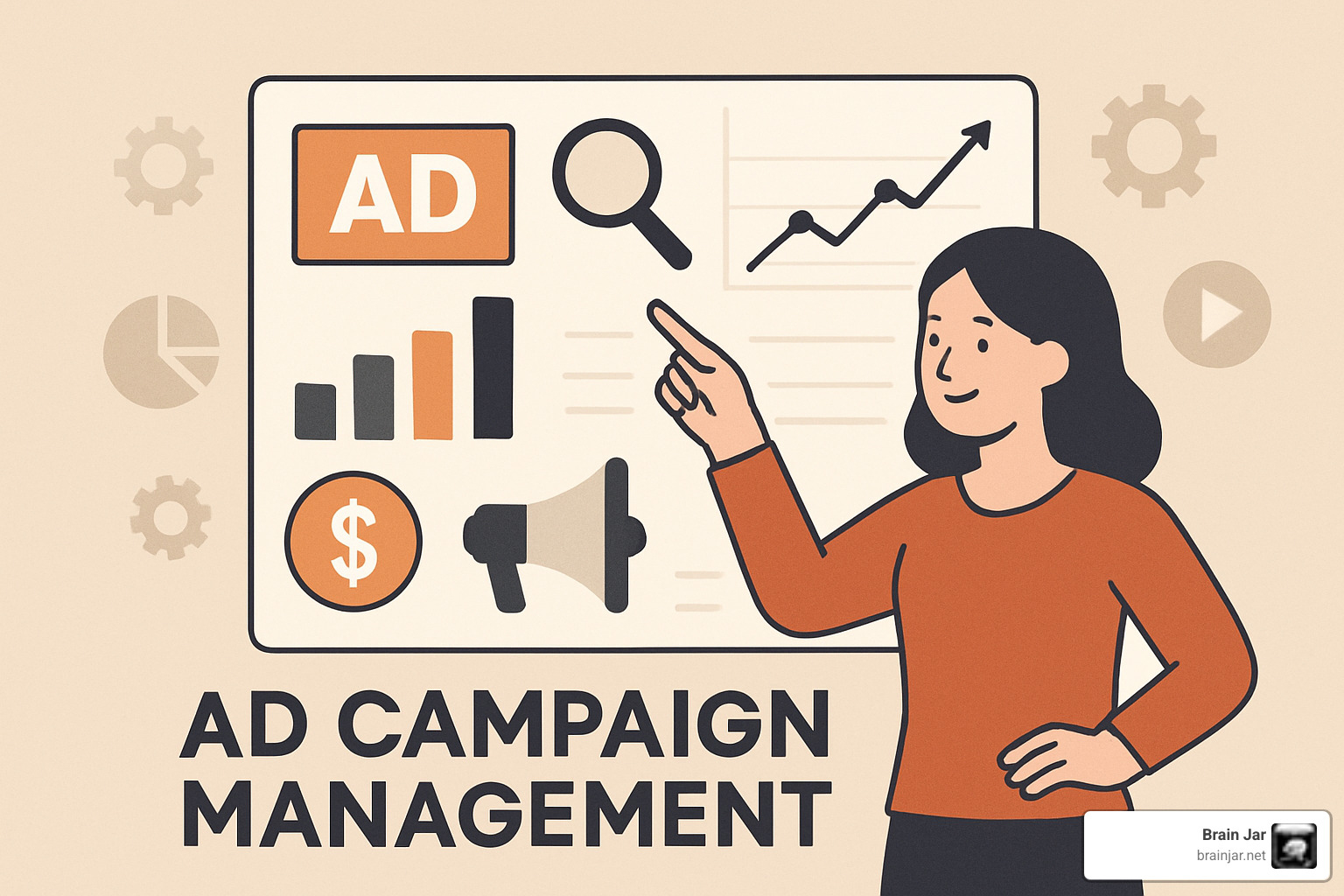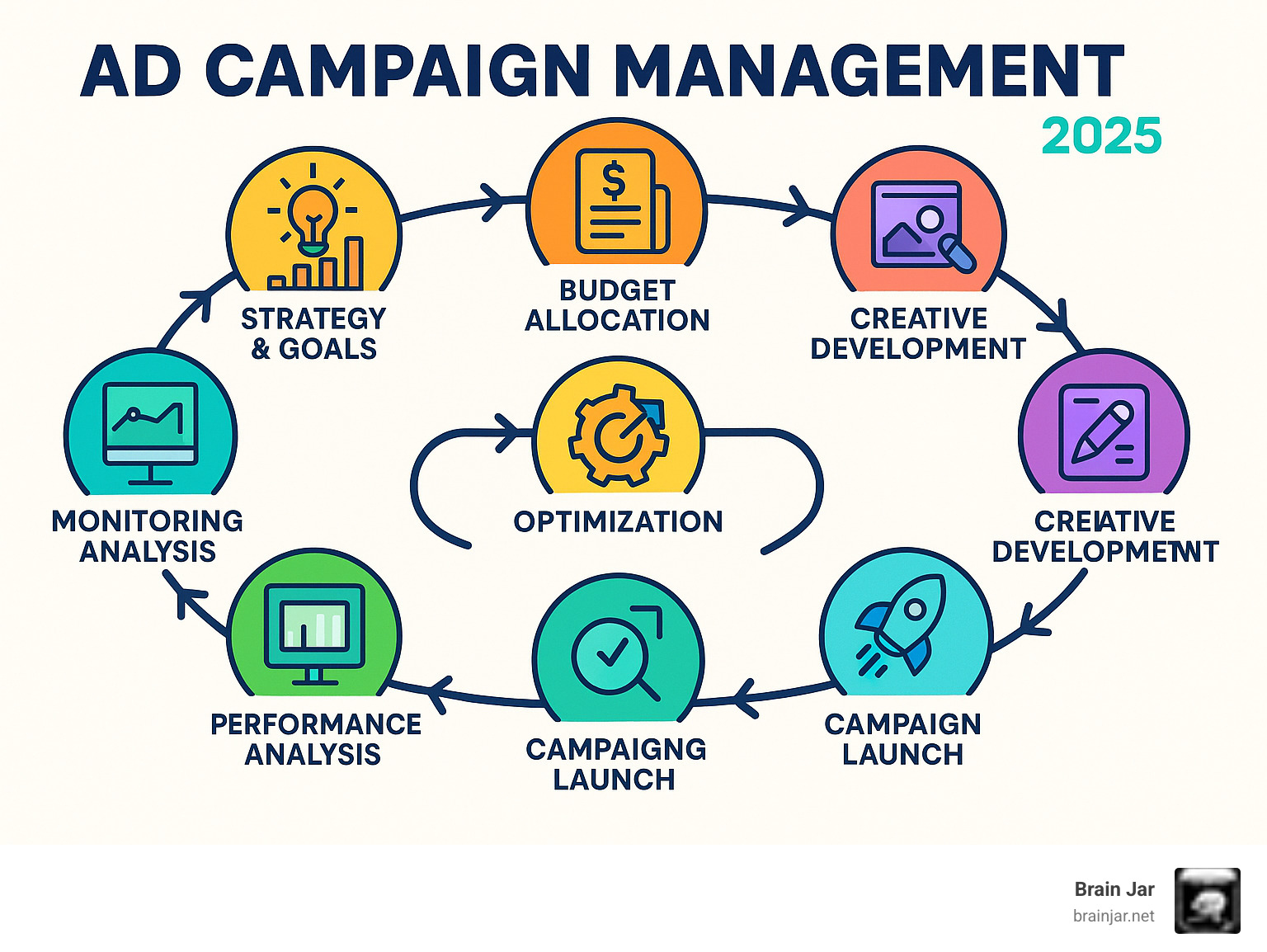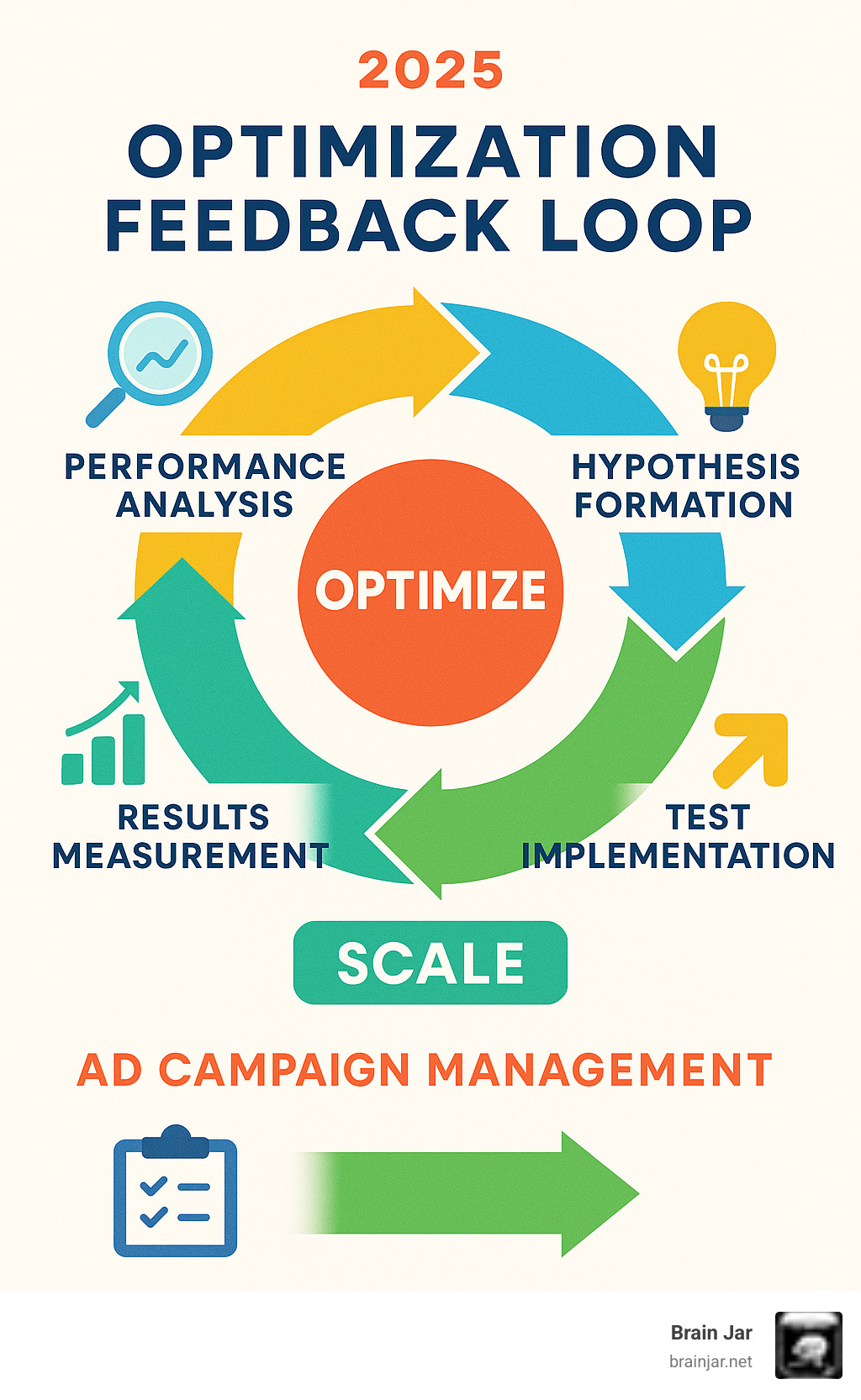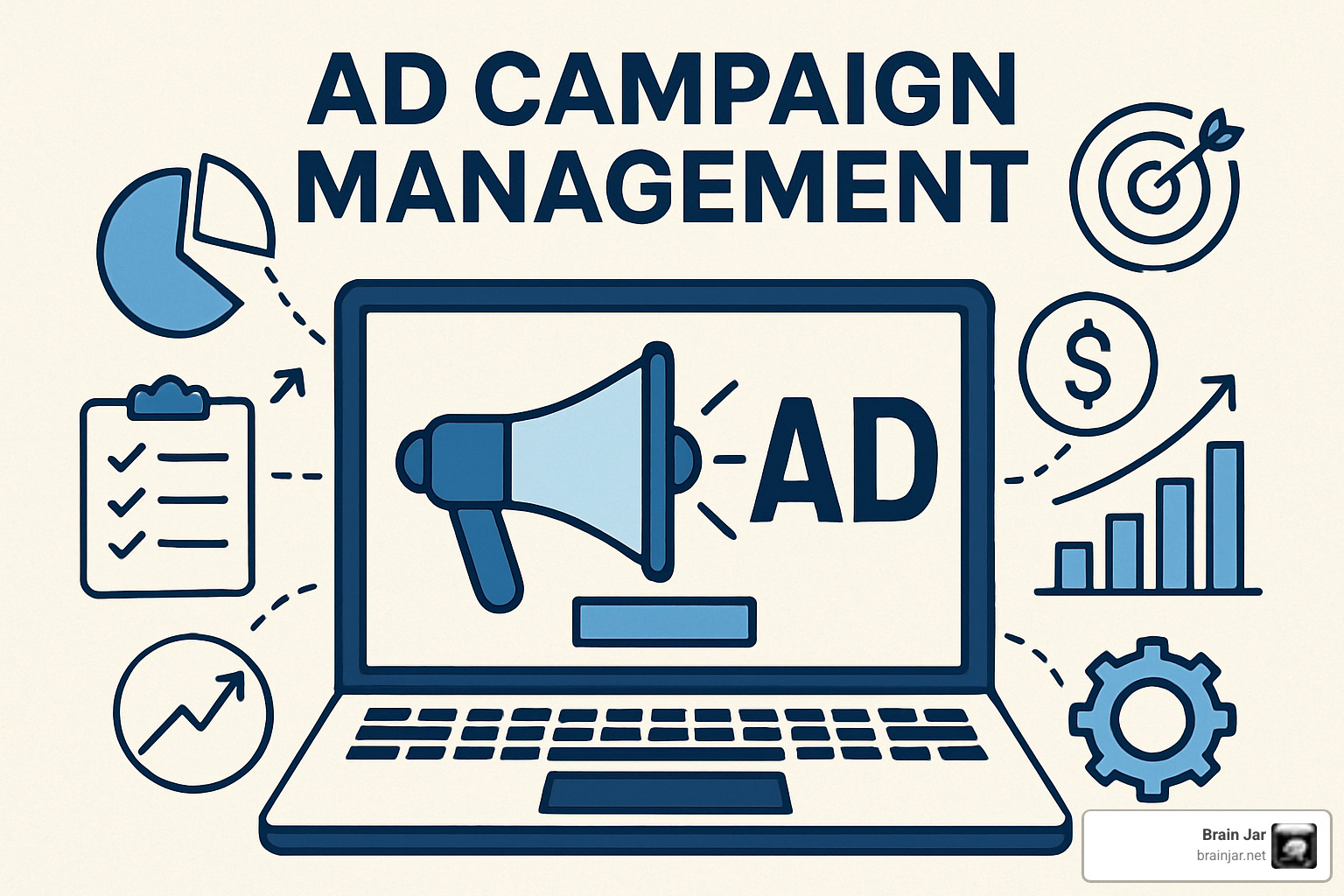Why Ad Campaign Management Is the Key to Marketing Success

Ad campaign management is the strategic process of planning, executing, and optimizing marketing campaigns across multiple channels to achieve specific business objectives. It involves coordinating budgets, timelines, creative assets, audience targeting, and performance tracking to ensure every dollar spent drives measurable results.
Quick Answer: What is Ad Campaign Management?
- Planning: Setting clear goals, budgets, and target audiences
- Execution: Launching campaigns across chosen channels (search, social, display)
- Monitoring: Tracking performance metrics in real-time
- Optimization: Adjusting bids, creatives, and targeting based on data
- Reporting: Analyzing results and ROI to inform future campaigns
The stakes have never been higher. 78% of advertising professionals cite campaign management challenges as the most difficult part of their job. Yet businesses that plan campaigns proactively are 356% more likely to report success.
Consider McDonald’s BTS Meal campaign – through strategic ad campaign management, they generated 11.5 million social media mentions and achieved a 250% increase in Chicken McNuggets sales over four weeks. This wasn’t luck; it was systematic campaign orchestration.
I’m HJ Matthews, Business Development Manager at Brain Jar, and I’ve spent over 15 years navigating ad campaign management across industries from aviation to entertainment.

Why Effective Ad Campaign Management Matters
Effective ad campaign management transforms advertising from guesswork into a predictable growth engine. When you master campaign management, four game-changing benefits emerge.
Cost efficiency becomes your superpower. We’ve watched businesses slash their cost-per-acquisition by 29% simply by stopping budget bleed from poor targeting. Brand consistency ensures your message stays unified across every platform. Revenue growth turns ads from expenses into reliable revenue drivers. Data-driven agility gives you real-time insights to pivot faster than competitors.
Business Impact & Key Stats
McDonald’s BTS Meal campaign generated 11.5 million social media mentions and achieved potential reach of 74.6 billion through coordinated ad campaign management. The scientific research on cultural resonance reveals how systematic campaign orchestration delivered these results.
A global entertainment company cut cost per signup by 29% and cost per purchase by 19% in just four weeks through systematic optimization. Vuori reduced cost per purchase by 17% by reallocating ad spend based on performance data.
Coca-Cola used AI-driven personalized marketing to increase social media engagement by 20%, boost targeted email conversion rates by 15%, and drive online sales up by 25%. The pattern is clear: businesses that treat campaign management as a strategic discipline consistently outperform those that don’t.
Mastering Ad Campaign Management: The 7-Step Framework
After managing hundreds of campaigns across industries, I’ve seen the same pattern repeat. Successful campaigns follow a predictable blueprint, while those that drain budgets skip crucial steps.
This framework scales from local restaurants increasing foot traffic by 40% to enterprise clients reducing cost-per-acquisition by double digits. The fundamentals remain the same – only complexity changes.
Successful campaigns require: goal setting beyond vanity metrics, thorough audience research revealing genuine insights, smart budgeting maximizing every dollar, strategic channel selection based on audience behavior, creative production that resonates emotionally, precise timeline mapping, and continuous optimization compounding results.
The magic happens when these elements work together, changing break-even experiments into profit-driving machines.
1. Set Objectives & KPIs
Campaigns that fail start with vague goals like “get more customers.” Successful ones begin with laser-focused objectives everyone can rally behind.
The SMART Goals Framework forces clarity. Instead of “increase online sales,” define goals like “generate 500 new customer acquisitions within 90 days with maximum cost-per-acquisition of $25.”
SMART goals require: Specific objectives with no ambiguity, Measurable numbers you can track, Achievable targets based on budget and market conditions, Relevant alignment with business objectives, and Time-bound deadlines creating accountability.
The challenge is selecting the right Key Performance Indicators (KPIs). Focus on 3-5 primary indicators that truly matter.
Separate value metrics from vanity metrics. Value metrics directly impact your bottom line – Return on Ad Spend (ROAS), Customer Acquisition Cost (CAC), and actual conversion rates.
| Metric Type | Examples | Why It Matters |
|---|---|---|
| Value Metrics | ROAS, CAC, Revenue Attribution, Lifetime Value Ratio | Directly impacts profitability and business growth |
| Vanity Metrics | Impressions, Social Followers, Video Views (without conversion tracking) | Interesting to know but doesn’t drive business decisions |
Set both primary objectives focusing on revenue and secondary objectives capturing longer-term brand building for complete campaign performance visibility.
2. Decode Your Audience
Successful ad campaign management speaks to real people with real problems, not just demographics. Two identical 35-year-old marketing managers might have completely different behaviors and preferences.
Building Real Personas goes beyond basic templates. We dig into motivations behind demographics. What keeps your ideal customer awake at 2 AM? What’s their biggest frustration?
A software company targeting “small business owners” finded their best customers were specifically second-generation family business owners feeling pressure to modernize while respecting tradition. This insight improved conversion rates by 43%.
Social listening reveals actual words people use. Instead of “optimize efficiency,” your audience might say “stop wasting time on stupid tasks.” Guess which phrase performs better in ads?
Behavioral segmentation tracks how different segments actually behave. Someone visiting your pricing page three times needs different messaging than someone downloading every free resource.
For unconventional audience insights your competitors miss, our Guerilla Marketing services help uncover hidden opportunities.
Geographic nuances matter more than expected. Regional differences can make or break campaigns due to subtle cultural references that don’t translate.
The breakthrough comes when you realize your audience isn’t one group – it’s several distinct segments with different needs and behaviors. Speaking to segments individually instead of trying to please everyone makes ad campaign management infinitely more effective.
3. Budget & Resource Allocation
Smart budget allocation can make or break ad campaign management success. The secret is finding the balance between playing it safe and taking calculated risks.
Media Mix Modeling Approach
We use the 70-20-10 rule based on campaign data. 70% goes to proven, high-performing channels where you know you’ll get results. 20% gets allocated for optimization and scaling existing successful campaigns. 10% is experimental budget for testing new channels and audiences.
Cost Ceiling Strategy
Establish maximum cost-per-acquisition thresholds before launch to prevent nightmare scenarios where platforms spend your entire budget in one weekend. These aren’t set in stone but provide clear guardrails.
Scenario Planning
Plan for three outcomes: best case (how to scale success), expected case (standard optimization procedures), and worst case (when to pause and reallocate budget). Having these decisions made upfront prevents emotional spending.
Milestone Reviews
Weekly budget performance reviews with monthly strategic assessments keep campaigns on track. Campaigns reviewed weekly consistently perform 25% better than those checked monthly. This systematic approach transforms advertising from guessing into predictable growth.
4. Channel Strategy & Placement
Choosing the right channels isn’t about casting the widest net – it’s about finding where your audience feels most receptive to your message.
The Channel Ecosystem Approach
Treat channels as teammates working toward the same goal. Search marketing captures high-intent prospects ready to act. Social media platforms excel at building awareness and engagement. Display advertising keeps your brand visible during the decision journey. Video platforms give space to demonstrate value. Emerging channels offer opportunities in less crowded spaces.
Your campaign objectives matter too. Brand awareness campaigns thrive on social and video platforms, while direct response campaigns often perform better on search and display networks.
Cross-Device Reality
People constantly switch between devices – researching on phones, continuing on laptops, purchasing on tablets. Smart campaigns ensure your message works seamlessly across all screen sizes and optimize timing based on when people use each device type.
The key is creating a cohesive experience that feels natural regardless of where someone encounters your brand.
5. Craft High-Impact Creatives
Creative assets are where strategy meets emotion. Campaigns with identical budgets and targeting produce completely different results based purely on creative quality and relevance.
The secret is storytelling – even in seconds. Every successful creative follows this structure: hook (capture attention in three seconds), problem (identify audience frustration), solution (present your answer), proof (build credibility), call-to-action (tell them what to do next).
User-generated content consistently outperforms polished studio productions. Real customers sharing experiences resonates more than traditional advertising. We’ve seen engagement rates jump 30% featuring genuine customer stories.
A/B testing makes creative development scientific. Test one variable at a time – headlines, images, or call-to-action buttons. Wait for statistical significance before making decisions and document learnings.
Emotional triggers drive conversions more than logical arguments. Fear of missing out creates urgency. Social proof builds trust. Authority establishes credibility. Reciprocity through free resources makes people want to give back.
Accessibility ensures everyone can engage with your message. Every creative needs alt text, captions, and high contrast ratios. Many accessibility features improve performance for all users.
6. Launch & Real-Time Monitoring
Campaign launch is when planning meets reality. Success requires systems to monitor performance and respond quickly to data insights.
Pre-Launch Checklist:
- Tracking pixels properly installed
- Conversion goals configured
- Budget limits and bid strategies set
- Creative assets approved and uploaded
- Audience targeting parameters verified
- Landing pages tested across devices
Real-Time Monitoring Systems:
Instant Reporting: Dashboards updating hourly during first 48 hours catch issues before they become expensive problems.
Anomaly Alerts: Automated notifications when performance deviates significantly from expected ranges.
Pacing Controls: Monitor spend rate to ensure budgets last intended duration while maximizing exposure during peak windows.
Key Metrics Timeline:
- First 6 Hours: Click-through rates, initial conversion signals
- First 24 Hours: Cost-per-click trends, audience engagement patterns
- First Week: Conversion rates, cost-per-acquisition, return on ad spend
Data from these periods informs optimization decisions improving campaign performance by 20-40% compared to “set it and forget it” approaches.
7. Analyze, Optimize, Scale

This phase transforms mediocre campaigns into powerhouses. The difference between good and great campaigns isn’t initial setup – it’s what you do with emerging insights.
Multi-touch attribution reveals the complete customer journey. That Google ad conversion might have started with a Facebook video. Understanding the full path helps make smarter budget decisions.
The Four Pillars of Optimization
Bid modifiers become precision tools with performance data. Mobile users might convert 40% better on weekends, or certain cities have twice the lifetime value.
Creative rotation prevents audience fatigue. Test new variations while retiring underperformers based on systematic data analysis.
Budget redistribution follows math and strategy. When Campaign A generates leads at $15 each while Campaign B costs $45 per lead, gradually shift budget toward winners.
Audience refinement gets sophisticated as data accumulates. “Small business owners” might reveal restaurant owners convert three times better than retail owners.
Smart Scaling Strategies
Horizontal scaling expands what works carefully. Vertical scaling increases spend gradually while monitoring efficiency. Creative scaling develops variations of winning themes.
The Optimization Rhythm: Daily monitoring catches major issues, weekly analysis guides bid adjustments, bi-weekly testing introduces fresh concepts, monthly reviews examine strategic direction.
Optimization never stops. Campaigns receiving consistent attention typically outperform “set it and forget it” approaches by 50% or more.
Tools & Technology Powering Today’s Campaigns
Modern ad campaign management requires technology that handles heavy lifting while you focus on strategy. The right tools mean automated bid adjustments, AI insights spotting opportunities, and unified dashboards eliminating platform juggling.
Automation handles bid adjustments, budget redistribution, and creative rotation automatically. AI-powered insights identify patterns in massive datasets, predict optimal bids, and suggest audience segments. Dashboard integration provides cross-channel performance visibility. CRM integration tracks complete customer journeys. Security features ensure compliance automatically.
Essential Stack Checklist
Your stack needs five key areas: Ad servers for multi-channel campaign management, project management tools for team coordination, analytics suites showing real business impact, reporting tools automating stakeholder updates.
For comprehensive campaign performance, our Website Supervision and QA services ensure landing pages convert at maximum rates.
AI & Automation for Ad Campaign Management
Predictive bidding processes thousands of data points per auction, determining optimal bids in milliseconds. Generative creatives create multiple variations maintaining brand voice. Dynamic segmentation identifies high-value customer groups based on behavior patterns.
The scientific research on AI-personalization shows Coca-Cola achieved 20% higher social engagement, 15% better email conversions, and 25% increased online sales through AI-driven campaigns.
Start small with one AI feature like automated bidding, then scale gradually while maintaining human oversight.
Troubleshooting & Pro Tips
Most campaign challenges follow predictable patterns. Knowing what to watch for helps solve issues before they drain budgets.
The Four Campaign Killers: Misaligned teams create chaos when departments don’t communicate. Budget bloat happens when automated bidding gets aggressive without monitoring. Creative fatigue occurs when audiences tire of seeing identical ads. Data silos prevent seeing the complete performance picture.
Overcoming Budget Overruns
Pacing rules spread spending throughout the day like cruise control. Bid caps serve as safety nets – set maximum amounts at 150% of target cost-per-click. Real-time reallocation moves money from underperforming to successful campaigns daily. Emergency protocols establish clear criteria for automatic campaign pausing.
Ensuring Cross-Channel Consistency

Brand guidelines need practical specifications anyone can follow – exact colors, fonts, logos, and tone examples. Content hubs provide shared access to approved assets. Unified messaging adapts core value propositions for each platform while maintaining consistency. Quality assurance catches inconsistencies before launch.
Maintaining Compliance & Privacy
PII redaction carefully handles personal information. Consent flows should be simple and clear, explaining value exchange. Policy checklists keep you updated as platform rules change. Documentation protects your business with records of consent and data usage.
Frequently Asked Questions about Ad Campaign Management
What metrics define a successful campaign?
Revenue metrics should be your North Star: Return on Ad Spend (ROAS), Customer Acquisition Cost (CAC), and revenue attribution. Efficiency metrics like cost-per-click and conversion rates reveal targeting effectiveness. Business impact metrics including customer lifetime value connect campaigns to long-term success.
Focus on 3-5 primary metrics directly connecting to business objectives rather than tracking dozens of vanity metrics.
How often should we refresh creatives?
Large audiences (100,000+ people) can handle testing new creatives every 2-3 weeks. Medium audiences (10,000-100,000) need monthly updates. Smaller audiences (under 10,000) work better with quarterly refreshes.
Watch for declining click-through rates or increasing cost-per-click signaling creative fatigue before performance tanks.
When is it time to scale or pause spend?
Scale campaigns when ROAS consistently exceeds targets by 20% for at least a week with sufficient conversion volume (30+ conversions) and confirmed market opportunity.
Pause campaigns when cost-per-acquisition exceeds maximum thresholds for 7+ consecutive days or ROAS falls below break-even for 2+ weeks.
Stay disciplined – trust trends over daily fluctuations. Good campaigns have bad days; bad campaigns occasionally have good days.
Conclusion
When you master ad campaign management, advertising becomes your most reliable growth engine. The seven-step framework transforms marketing budgets into predictable revenue streams through systematic execution.
Clear objectives guide every decision. Deep audience insights create personal conversations. Strategic channel selection ensures you’re reaching the right people. Continuous optimization turns initial success into sustained growth.
At Brain Jar, we’ve perfected this approach with clients across Southern California and beyond. The most successful campaigns happen when strategic thinking meets systematic execution – great creative and smart targeting working together.
Technology evolves and platforms emerge, but fundamentals remain: understand your audience deeply, craft resonant messages, choose the right channels, and never stop optimizing based on performance data.
Whether managing your first Google Ads campaign or million-dollar brand initiatives, these principles scale beautifully. Local bakeries and Fortune 500 companies both need clear objectives, compelling creatives, and data-driven optimization.
Ready to stop guessing and start growing? Our SEO Services Gold Plan brings together paid advertising and organic search strategy, creating unified approaches that amplify results across every channel.
When everyone’s shouting for attention, strategic ad campaign management cuts through noise and connects with people who matter most to your business. The question isn’t whether professional campaign management works – the data proves it does. The real question is how much growth you’re leaving on the table by not implementing these systems today.

